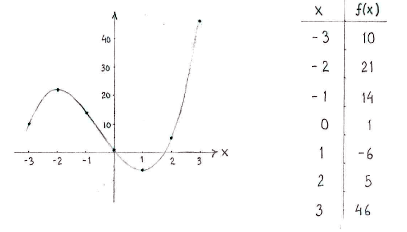Lösung 1.3:2c
Aus Online Mathematik Brückenkurs 2
K (Solution 1.3:2c moved to Lösung 1.3:2c: Robot: moved page) |
|||
| Zeile 1: | Zeile 1: | ||
| - | + | Lokale Extrempunkte einer Funktion sind entweder: | |
| - | # | + | # stationäre Punkte, wo <math>f^{\,\prime}(x)=0</math>, |
| - | # | + | # Singuläre Punkte, wo die Funktion nicht ableitbar ist, oder |
| - | # | + | # Endpunkte. |
| + | |||
| + | Nachdem die Funktion ein Polynom ist, ist sie überall definiert, und überall ableitbar. Also gibt es keine Extrempunkte die die Bedienungen 2 und 3 erfüllen. | ||
| - | + | Die Ableitung als null gesetzt ergibt folgende Gleichung | |
| - | + | ||
| - | + | ||
{{Abgesetzte Formel||<math>f^{\,\prime}(x) = 6x^2+6x-12 = 0\,\textrm{.}</math>}} | {{Abgesetzte Formel||<math>f^{\,\prime}(x) = 6x^2+6x-12 = 0\,\textrm{.}</math>}} | ||
| - | + | Dividieren wir durch 6 erhalten wir durch quadratische Ergänzung | |
{{Abgesetzte Formel||<math>\Bigl(x+\frac{1}{2}\Bigr)^2 - \Bigl(\frac{1}{2}\Bigr)^2 - 2 = 0\,\textrm{.}</math>}} | {{Abgesetzte Formel||<math>\Bigl(x+\frac{1}{2}\Bigr)^2 - \Bigl(\frac{1}{2}\Bigr)^2 - 2 = 0\,\textrm{.}</math>}} | ||
| - | + | Und wir erhalten die Gleichung | |
{{Abgesetzte Formel||<math>\Bigl(x+\frac{1}{2}\Bigr)^2 = \frac{9}{4}</math>}} | {{Abgesetzte Formel||<math>\Bigl(x+\frac{1}{2}\Bigr)^2 = \frac{9}{4}</math>}} | ||
| - | + | mit den Lösungen | |
{{Abgesetzte Formel||<math>\begin{align} | {{Abgesetzte Formel||<math>\begin{align} | ||
| Zeile 29: | Zeile 29: | ||
<math>x=-2</math> and <math>x=1</math>. | <math>x=-2</math> and <math>x=1</math>. | ||
| - | + | Wir erstellen eine Vorzeichentabelle, und erhalten so die Extrempunkte. | |
{| border="1" cellpadding="5" cellspacing="0" align="center" | {| border="1" cellpadding="5" cellspacing="0" align="center" | ||
| Zeile 55: | Zeile 55: | ||
|} | |} | ||
| + | Die Funktion hat also ein lokales Maxima in <math>x=-2</math> und ein lokales Minima in <math>x=1</math>. | ||
| - | + | Berechnen wir den Funktionswert in einigen Punkten, können wir mit Hilfe der Vorzeichentabelle die Funktion zeichnen. | |
| - | + | ||
| - | + | ||
[[Image:1_3_2_c.gif|center]] | [[Image:1_3_2_c.gif|center]] | ||
Version vom 16:30, 26. Apr. 2009
Lokale Extrempunkte einer Funktion sind entweder:
- stationäre Punkte, wo \displaystyle f^{\,\prime}(x)=0,
- Singuläre Punkte, wo die Funktion nicht ableitbar ist, oder
- Endpunkte.
Nachdem die Funktion ein Polynom ist, ist sie überall definiert, und überall ableitbar. Also gibt es keine Extrempunkte die die Bedienungen 2 und 3 erfüllen.
Die Ableitung als null gesetzt ergibt folgende Gleichung
| \displaystyle f^{\,\prime}(x) = 6x^2+6x-12 = 0\,\textrm{.} |
Dividieren wir durch 6 erhalten wir durch quadratische Ergänzung
| \displaystyle \Bigl(x+\frac{1}{2}\Bigr)^2 - \Bigl(\frac{1}{2}\Bigr)^2 - 2 = 0\,\textrm{.} |
Und wir erhalten die Gleichung
| \displaystyle \Bigl(x+\frac{1}{2}\Bigr)^2 = \frac{9}{4} |
mit den Lösungen
| \displaystyle \begin{align}
x &= -\frac{1}{2}-\sqrt{\frac{9}{4}} = -\frac{1}{2}-\frac{3}{2} = -2\,,\\[5pt] x &= -\frac{1}{2}+\sqrt{\frac{9}{4}} = -\frac{1}{2}+\frac{3}{2} = 1\,\textrm{.} \end{align} |
This means that if the function has several extreme points, they must be among \displaystyle x=-2 and \displaystyle x=1.
Wir erstellen eine Vorzeichentabelle, und erhalten so die Extrempunkte.
| \displaystyle x | \displaystyle -2 | \displaystyle 1 | |||
| \displaystyle f^{\,\prime}(x) | \displaystyle + | \displaystyle 0 | \displaystyle - | \displaystyle 0 | \displaystyle + |
| \displaystyle f(x) | \displaystyle \nearrow | \displaystyle 21 | \displaystyle \searrow | \displaystyle -6 | \displaystyle \nearrow |
Die Funktion hat also ein lokales Maxima in \displaystyle x=-2 und ein lokales Minima in \displaystyle x=1.
Berechnen wir den Funktionswert in einigen Punkten, können wir mit Hilfe der Vorzeichentabelle die Funktion zeichnen.

